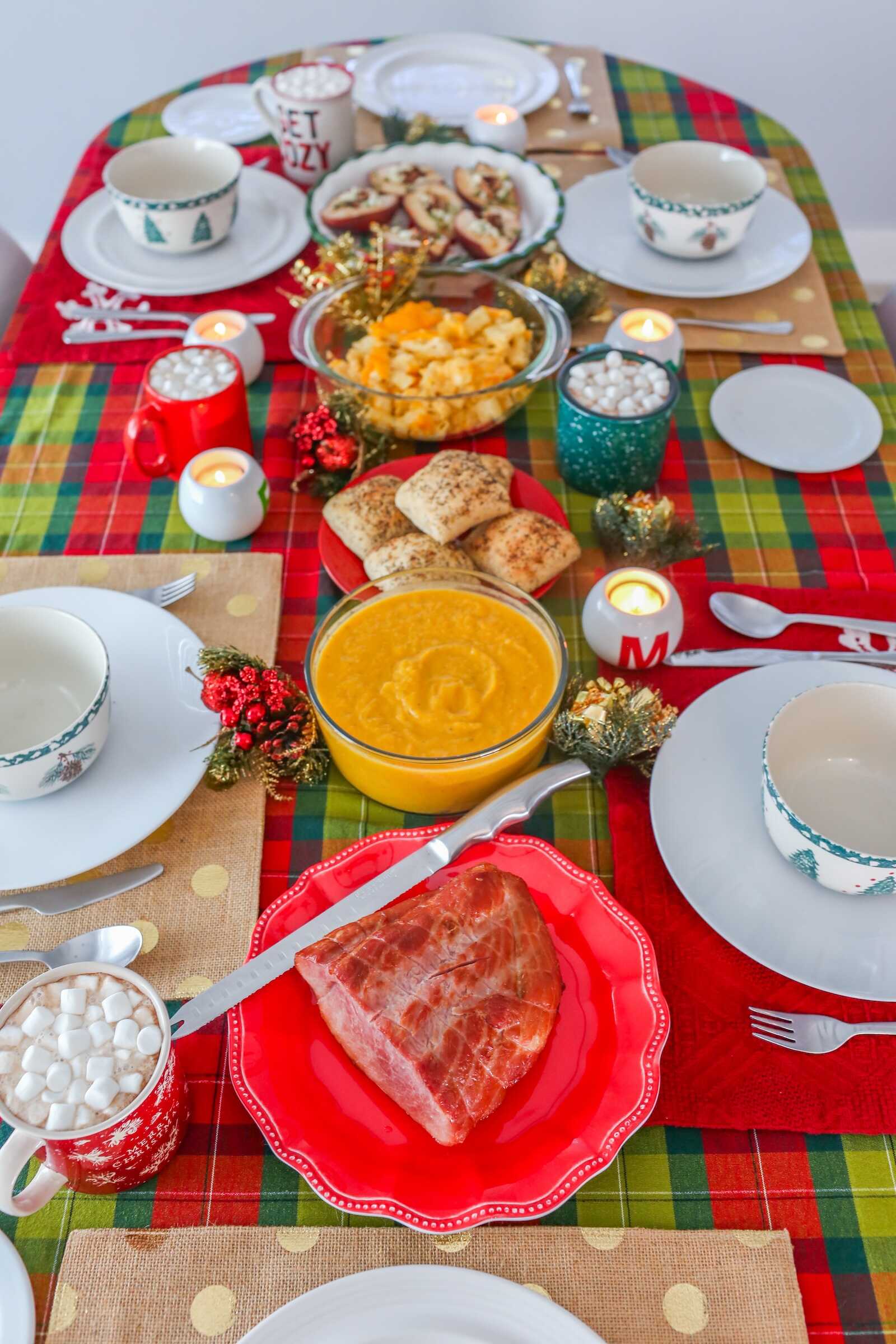Christmas Ham Dinner – Side Dishes and Dessert to Serve with Main Course


Among the many culinary delights that grace holiday tables, the Christmas ham holds a special place. In this holiday meal planning guide, we explore the timeless tradition of the Christmas ham dinner. My family has strong Irish roots, so my mom especially loves a good ham main course. Also, my husband and I love the holiday movie Christmas with the Kranks, and the “honey backed ham” scene is always hilarious.
From selecting the perfect ham to crafting complementary sides and dessert, we’ll delve into every aspect of creating a memorable holiday spread that will be throughly enjoyed by your guests. Whether you’re hosting an intimate gathering with family or a festive soirée with friends, our holiday meal planning guide is your roadmap to creating a Christmas ham dinner.

History of the Christmas Ham Dinner
The history of the Christmas ham dinner is a tale woven with traditions from across the centuries, spanning continents and cultures. Its roots can be traced back to ancient pagan celebrations, where feasting on pork was a symbol of prosperity and abundance during the winter solstice.
As Christianity spread throughout Europe, the tradition of eating ham at Christmas became intertwined with religious customs, with some linking it to the story of the Nativity and the symbolism of the pig as a representation of good luck.
In medieval times, the Christmas ham took on even greater significance, as families would raise their own pigs throughout the year, slaughtering them in time for the holiday feast. Over the centuries, the Christmas ham evolved, adapting to regional tastes and culinary innovations.


All the Different Types of Ham Explained
When it comes to choosing a ham for your Christmas dinner or any special occasion, the options can be overwhelming. Here’s a breakdown of the different types of ham you might encounter:
Whole Ham
This is the entire hind leg of a pig, cured and sometimes smoked. It’s typically quite large and can weigh anywhere from 10 to 20 pounds or more. Whole hams are often sold bone-in and can be either “fresh” or “country-cured.”
Spiral-Cut Ham
This is a whole ham that has been pre-sliced in a spiral pattern around the bone, making it easy to serve. Spiral-cut hams are usually fully cooked and may be glazed or smoked for added flavor.
Bone-In Ham
As the name suggests, this type of ham includes the bone, which adds flavor and helps keep the meat moist during cooking. Bone-in hams can be whole or sliced, and they come in a variety of styles, including smoked, cured, and uncooked.
Boneless Ham
This is a ham that has had the bone removed, making it easier to slice and serve. Boneless hams can be fully cooked or uncooked, and they may be cured or uncured.
Smoked City Ham
City hams are brined or cured with a wet cure, which typically includes a mixture of water, salt, sugar, and spices. They are usually smoked and may be fully cooked or partially cooked. City hams tend to have a milder flavor compared to country hams.
Country Ham
Country hams are dry-cured with a mixture of salt and spices and then aged for several months to develop flavor. They are often smoked and may be fully cooked or uncooked. Country hams have a rich, salty flavor and a dense, chewy texture.
Black Forest Ham
Originating from the Black Forest region of Germany, this type of ham is dry-cured with a blend of salt, sugar, and spices and then smoked over pine wood. It has a distinctively rich flavor and is often thinly sliced for sandwiches or charcuterie boards.
Honey Baked Ham
Starting with a premium quality ham, typically bone-in or boneless, preparations begin with a generous glaze of honey and other carefully selected ingredients. The ham is skillfully spiral-sliced, allowing the sweet glaze to penetrate every layer, ensuring each bite has flavor. As it bakes, the honey caramelizes, creating a glossy, golden-brown crust


Cooking Options for Your Holiday Ham
Holiday ham is a versatile dish that can be cooked using various methods, each yielding its own unique flavor and texture. Here are some of the most popular ways to cook a holiday ham:
Baking
Baking is the most traditional method for cooking a holiday ham. Preheat your oven, place the ham in a roasting pan, and cover it with foil to prevent drying out. Bake at a low to moderate temperature (usually around 325°F to 350°F or 160°C to 175°C) until heated through, basting occasionally with a glaze for added flavor.
Glazing
Glazing is a classic technique used to enhance the flavor and appearance of a holiday ham. Once the ham is partially cooked, remove it from the oven, brush with a flavorful glaze made from ingredients like honey, brown sugar, mustard, maple syrup, or fruit juices, and return it to the oven to finish baking until the glaze caramelizes and forms a shiny crust.
Slow Cooking
Slow cooking is a convenient method for busy holiday hosts. Place the ham in a slow cooker or crockpot, add a small amount of liquid (such as water, broth, or fruit juice) to keep it moist, and cook on low heat for several hours until tender and heated through. Slow cooking allows the flavors to meld together beautifully, resulting in a juicy and flavorful ham.
Grilling
Grilling adds a delightful smoky flavor to holiday ham and is perfect for outdoor gatherings. Preheat your grill to medium heat, place the ham on the grill grates, and cook for about 10-15 minutes per pound, turning occasionally, until heated through and lightly charred. You can also brush the ham with a glaze or marinade while grilling for extra flavor.
Smoking
Smoking is another fantastic way to infuse holiday ham with rich, smoky flavor. Prepare your smoker according to the manufacturer’s instructions, add wood chips for smoke flavor (such as hickory, applewood, or cherry), and smoke the ham at a low temperature (around 225°F to 250°F or 107°C to 121°C) for several hours until fully cooked and infused with smoky goodness.
Boiling
Boiling is a quick and easy method for cooking pre-cooked or fully cooked holiday ham. Simply place the ham in a large pot or Dutch oven, cover it with water or broth, add aromatic ingredients like onions, garlic, and herbs for extra flavor, and simmer gently until heated through. Boiling can also help to mellow the saltiness of cured hams.


How to Serve and Carve a Holiday Ham
Serving and carving a holiday ham is a time-honored tradition that adds to the festive atmosphere of any gathering. Here’s a step-by-step guide to help you serve and carve your holiday ham with confidence:
Serving
Presentation
Transfer the cooked ham to a large serving platter or carving board. If desired, garnish the platter with fresh herbs, citrus slices, or other decorative elements to enhance its visual appeal.
Temperature
Ensure the ham is still warm when serving, as this will maximize its flavor and juiciness. If necessary, tent the ham with foil to keep it warm until ready to carve.
Accompaniments
Arrange serving utensils, condiments, and any side dishes you’ll be serving alongside the ham, such as rolls, mustard, or fruit preserves, on the table for easy access.
Carving
Preparation
Place the ham on a stable surface and gather your carving tools, including a sharp carving knife and a carving fork. If your ham has a bone-in, identify the bone’s location and plan your carving accordingly.
Slicing
Begin by slicing off a thin layer of skin and any excess fat from the top of the ham to expose the meat. Then, using a sharp knife, make a diagonal slice along the natural seam where the meat meets the bone to create the first serving portion.
Bone-In Ham
For a bone-in ham, locate the bone and carve slices perpendicular to it, starting from the widest end of the ham and working your way towards the bone. Once you reach the bone, use the knife to cut along its contours, releasing each slice.
Boneless Ham
If you’re carving a boneless ham, slice perpendicular to the grain of the meat to create even, uniform slices. Aim for slices that are about ¼ to ½ inch thick, adjusting the thickness to your preference.
Presentation
Arrange the carved slices neatly on the serving platter, overlapping them slightly to create an attractive display. If desired, drizzle the slices with any remaining glaze or pan juices for added flavor and moisture.
Leftovers
Once the ham has been carved and served, promptly refrigerate any leftovers in an airtight container to maintain freshness and prevent spoilage. Leftover ham can be enjoyed in a variety of dishes, such as sandwiches, salads, soups, and casseroles.


Shopping for the Best Craving Knife for a Dinner Ham
Selecting the best carving knife for a dinner ham is crucial for achieving clean, precise slices that showcase the ham’s flavor and texture. Here are some features to consider when choosing the ideal carving knife:
Blade Length
Opt for a carving knife with a long, thin blade, typically around 8 to 12 inches in length. A longer blade allows for smooth, uninterrupted slicing motions, making it easier to carve thin, even slices of ham.
Blade Material
Look for a carving knife with a high-quality blade made from stainless steel or carbon steel. These materials offer excellent durability, sharpness, and resistance to corrosion, ensuring that the knife remains sharp and reliable for years to come.
Edge
Choose a carving knife with a razor-sharp edge that can effortlessly glide through the ham’s meat without tearing or shredding it. A knife with a finely honed, serrated edge or a traditional straight edge can both work well for carving ham, depending on your personal preference.
Handle Design
Consider the handle design of the carving knife, as it should provide a comfortable and secure grip for easy maneuverability. Look for a handle made from durable materials like wood, plastic, or stainless steel, with an ergonomic shape that fits comfortably in your hand.
Balance
Pay attention to the balance of the carving knife, ensuring that the weight is evenly distributed between the blade and the handle. A well-balanced knife will feel stable and controlled in your hand, allowing for precise slicing without exerting excessive force.
Brand Reputation
Choose a carving knife from a reputable kitchenware brand known for producing high-quality, reliable knives. Brands like Wüsthof, Victorinox, Zwilling J.A. Henckels, and Shun are all trusted names in the world of culinary knives and offer a wide range of carving knives to suit different preferences and budgets.
Ultimately, the best carving knife for a dinner ham is one that feels comfortable and balanced in your hand, with a sharp, sturdy blade that can effortlessly slice through the meat to create perfect portions every time.

The Best Side Dishes To Serve with a Dinner Ham
When it comes to serving a delicious dinner ham, the right side dishes can elevate the meal to new heights, complementing the savory flavors of the ham with a delightful array of textures and tastes. Here’s a selection of the best side dishes to serve alongside your dinner ham:
Butternut Squash Soup
Creamy and comforting, butternut squash soup is the perfect starter for a holiday dinner featuring ham. Its rich, velvety texture and subtle sweetness pair beautifully with the savory notes of the ham, creating a harmonious balance of flavors. Garnish each bowl with a dollop of crème fraîche or a sprinkle of toasted pumpkin seeds.
Mashed Potatoes
Mashed potatoes have a smooth and creamy texture, along with a mild flavor, that provides a comforting contrast to the savory flavors of the ham. They’re incredibly versatile and can be customized to suit your personal preferences and dietary needs. Whether you prefer them fluffy or creamy, seasoned with garlic, herbs, or cheese, mashed potatoes can be adapted to complement the flavors of your ham and other dishes on the table.


Mac and Cheese
A classic comfort food favorite, mac and cheese is a crowd-pleasing side dish that pairs wonderfully with ham. Creamy, cheesy, and oh-so-satisfying, this indulgent dish adds a hearty element to your holiday spread. Opt for a homemade version with a blend of sharp cheddar, Gruyère, and Parmesan cheeses, or jazz it up with additions like crispy bacon, caramelized onions, or roasted vegetables for extra flavor and texture.
Sweet Potatoes
Sweet potatoes provide a culinary contrast to the savory taste of ham, adding a touch of sweetness to the meal that enhances its overall flavor profile. Their natural sweetness is a complement to the salty, smoky notes of the ham, creating a balance of flavors. Sweet potatoes can be prepared in a variety of ways to suit your taste preferences and dietary needs. Whether you prefer them roasted, mashed, baked, or even made into fries or gratin, sweet potatoes offer endless possibilities for creative and delicious side dishes that will impress your guests.


Savory Dinner Rolls
No holiday meal is complete without a basket of warm, freshly baked dinner rolls. Soft, fluffy, and lightly golden, these savory delights are the perfect vessel for sopping up the juices from your succulent ham. Whether you prefer classic yeast rolls, buttery biscuits, or cheesy garlic knots, freshly baked dinner rolls add a comforting touch to any dinner table and are sure to be a hit with guests of all ages.
Roasted Carrots
Roasted carrots add a pop of vibrant color to your dinner table, with their rich orange hue creating an eye-catching presentation that enhances the visual appeal of the meal. Roasting carrots caramelizes their natural sugars, resulting in a sweet and savory flavor that complements the richness of the ham perfectly. The sweetness of the roasted carrots balances out the salty and smoky notes of the ham, creating a balance of flavors.
Green Bean Casserole
Green bean casserole is a classic and comforting side dish. It features tender green beans enveloped in a mushroom sauce, creating a comforting texture that’s both satisfying and indulgent. The creamy sauce adds richness to the dish and complements the savory flavors of the ham perfectly. While this dish can be made with freshly cut green beans, I prefer the old nostalgic recipe with French-style cut canned green beans with canned cream of mushroom soup.


Asparagus
Asparagus has a fresh and vibrant flavor that adds a refreshing contrast to the heaviness of ham. Its slightly earthy and grassy notes complement the meatiness of the ham, creating a well-rounded and balanced meal. Whether roasted, grilled, steamed, sautéed, or even wrapped in prosciutto or bacon, asparagus offers endless possibilities for creative and delicious side dishes.
Roasted Brussels Sprouts
Brussels sprouts are a nutritional powerhouse, packed with vitamins, minerals, and antioxidants. These cruciferous vegetables, with their crispy leaves and caramelized edges add new textures to the dinner table. Brussels sprouts can be prepared roasted with olive oil, garlic, and herbs, drizzled with maple syrup or tossed with balsamic glaze and bacon.
Brussels sprouts are incredibly easy to prepare, making them a convenient option for busy holiday meals. Simply trim the tough ends of the Brussels sprouts, halve them lengthwise, toss them, and roast them in the oven until tender and caramelized. It’s a hassle-free side dish that allows you to focus on preparing the rest of your holiday feast.

Desserts to Serve After a Christmas Ham Dinner
Pumpkin Pie
Pumpkin pie is synonymous with the fall and winter seasons, making it an ideal dessert for holiday gatherings like a ham dinner. Its warm spices, creamy pumpkin filling, and buttery crust evoke feelings of comfort and nostalgia, making it a comforting and satisfying treat. Serve it with a dollop of whipped cream or a sprinkle of cinnamon for an extra touch of elegance.
Apple Pie
Apple pie is a universally loved dessert that needs no introduction. Whether you prefer a traditional double-crust pie, a rustic galette, or individual hand pies, there’s a style of apple pie to enjoy after a ham dinner. The cinnamon found in apple pie can especially pair well with a maple glazed ham.
Pecan Pie
Pecan pie is known for its rich, gooey filling packed with toasted pecans and sweetened with a caramel-like mixture of sugar, eggs, and corn syrup. The buttery, nutty flavor of pecan pie provides a delightful contrast to the savory taste of ham, creating a satisfying and indulgent treat that’s perfect for special occasions.
Baked Pears
For a sweet and elegant side dish that complements the savory flavors of ham, consider serving baked pears. The natural sweetness of the pears pairs beautifully with the salty richness of the ham, creating a delicious contrast of flavors that will leave your taste buds tingling. In this baked pear recipe, the gorgonzola cheese and walnuts are so rich and creamy. This dish is very versatile, can served as an appetizer or a light and tangy dessert.


Whether you’re hosting a gathering with family or a bigger Christmas party with friends, our holiday meal planning guide is your roadmap to creating a festive dinner that delights. So grab a cup of eggnog, gather around the table, and let the magic of the season unfold as you enjoy a culinary meal that celebrates the true spirit of Christmas.


